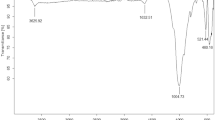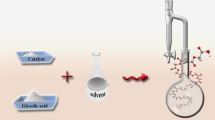Abstract
This research reports the successful synthesis of the cyclic poly(N-isopropyl acrylamide) (cPNIPAAM) by a new method. For this purpose, \(\alpha\), ω-difunctionalized precursor was synthesized, applying a free radical polymerization process in the methanol solvent, and using the nitroxide component, hydroxy-TEMPO, as the terminator for the first time. Then, end-to-end equilibrium, with an appropriate coupling agent, was utilized for cyclization reaction in the two solvents of water and dimethylformamide (DMF). Using a terminator to produce functionalized chains led to controlled molecular weight polymers. As a result, reduced molecular weight precursors were created, resulting in smaller rings with improved water solubility, LCST temperature and more environmentally compatible friendly products, particularly in medicinal objectives. In comparison with previous techniques, these characteristics represent the precise innovation of our study. The yield and optimum polymerization conditions were provided. The polymer products were characterized by FTIR, 1HNMR, GPS, TLC, DSC, DLS and viscometry methods. The morphology and molecular weight were compared with the previously produced polymers. The results confirmed the formation of polymers with lower molecular weight compared to previous methods. Despite its lower cyclization yield, water was a better solvent compared to DMF.
Graphical abstract










Similar content being viewed by others
Data availability
The datasets used and/or analyzed during the current study available from the corresponding author on reasonable request.
Abbreviations
- ATRP:
-
Atom transfer radical polymerization
- cPNIPAAM:
-
Cyclic poly(N-isopropylacrylamide)
- DLS:
-
Dynamic light scattering
- DMF:
-
Dimethylformamide
- DSC:
-
Differential scanning calorimetry
- DMSO:
-
Dimethyl sulfoxide
- FTIR:
-
Fourier transform infrared spectroscopy
- GPC:
-
Gel permeation chromatography
- HNMR:
-
Hydrogen nuclear magnetic resonance
- LCST:
-
Lower critical solution temperature
- M n :
-
The number average molecular weight
- M v :
-
Viscosity average molecular weight
- M w :
-
Weight average molecular weight
- NIPAAM:
-
N-Isopropylacrylamide
- NMP:
-
Nitroxide-mediated polymerization
- PNIPAAM:
-
Poly(N-isopropylacrylamide)
- RAFT:
-
Addition-fragmentation chain transfer
- T g :
-
Glass transition temperature
- T m :
-
Melting point
- TLC:
-
Thin layer chromatography
- THF:
-
Tetrahydrofuran
- W i :
-
Weight of initiator
- W m :
-
Weight of monomer
- W p :
-
Weigh of linear polymer
- W pi :
-
Weight of 2-chloro-1-methylpyridinium iodide
- W t :
-
Weight of terminator
- W tea :
-
Weight of triethylamine
References
Huaping T, Ramirez CM, Miljkovic N, Li H, PeterRubin J, Marra KG (2009) Thermosensitive injectable hyaluronic acid hydrogel for adipose tissue engineering. Biomaterials 30(36):6844–6853. https://doi.org/10.1016/j.biomaterials.2009.08.058
Drury JL, Mooney DJ (2003) Hydrogels for tissue engineering: scaffold design variables and applications. Biomaterials 24(24):4337–4351. https://doi.org/10.1016/S0142-9612(03)00340-5
Cosgriff-Hernandez E, Mikos AG (2008) New biomaterials as scaffolds for tissue engineering. Springer. https://doi.org/10.1007/s11095-008-9666-4
Pratt AB, Weber FE, Schmoekel HG, Müller R, Hubbell JA (2004) Synthetic extracellular matrices for in situ tissue engineering. Biotechnol Bioeng 86(1):27–36. https://doi.org/10.1002/bit.10897
Hennink WE, van Nostrum CF (2012) Novel crosslinking methods to design hydrogels. Adv Drug Deliv Rev 64:223–236. https://doi.org/10.1016/j.addr.2012.09.009
Gao C, Möhwald H, Shen J (2005) Thermosensitive poly(allylamine)-g-poly(N-isopropylacrylamide): synthesis, phase separation and particle formation. Polymer 46(12):4088–4097. https://doi.org/10.1016/j.polymer.2005.02.115
BucatariuFundueanuPrisacaruMihaela BalanStoicaHarabagiuConstantin SGIMIVM (2014) Synthesis and characterization of thermosensitive poly(N-isopropylacrylamide-co-hydroxyethylacrylamide) microgels as potential carriers for drug delivery. Polym Res 21(11):1–12. https://doi.org/10.1007/s10965-014-0580-7
Saunders BR, EmmaDaly NL, Teow S, Hu X, Stepto R (2009) Microgels: from responsive polymer colloids to biomaterials. Adv Colloid Interface Sci 147:251–262. https://doi.org/10.1016/j.cis.2008.08.008
Klinger D, Landfester K (2012) Stimuli-responsive microgels for the loading and release of functional compounds: fundamental concepts and applications. Polymer 53(23):5209–5231. https://doi.org/10.1016/j.polymer.2012.08.053
Lanzalaco S, Armelin E (2017) Poly(N-isopropylacrylamide) and copolymers: a review on recent progresses in biomedical applications. Gels 3(4):36. https://doi.org/10.3390/gels3040036
He W, Ma Y, Gao X, Wang X, Dai X, Song J (2020) Application of poly(N-isopropylacrylamide) as thermosensitive smart materials. J Phys Conf Ser. https://doi.org/10.1088/1742-6596/1676/1/012063
Jinming H, Liu S (2017) Topological effects of macrocyclic polymers: from precise synthesis to biomedical applications. Sci China Chem 60(9):1153–1161. https://doi.org/10.1007/s11426-017-9083-1
Xu J, Ye J, Liu S (2007) Synthesis of well-defined cyclic poly(N-isopropylacrylamide) via click chemistry and its unique thermal phase transition behavior. Macromolecules 40(25):9103–9110. https://doi.org/10.1021/ma0717183
McLeish T (2002) Polymers without beginning or end. J Sci 297(5589):2005–2006. https://doi.org/10.1126/science.1076810
Piromjitpong P, Ratanapanee P, Thumrongpatanaraks W, Kongsaeree P, Phomphrai K (2012) Synthesis of cyclic polylactide catalysed by bis (salicylaldiminato) tin(II) complexes. Dalton Trans 41(41):12704–12710. https://doi.org/10.1039/c2dt31678a
Ge Z, Wang D, Zhou Y, Liu H, Liu S (2009) Synthesis of organic/Inorganic hybrid quatrefoil-shaped star-cyclic polymer containing a polyhedral oligomeric silsesquioxane core. Macromolecules 42:2903–2910. https://doi.org/10.1021/ma802585k
Ge Z, Yueming Zhou Y, Xu J, Liu H, Chen D, Liu S (2009) High-efficiency preparation of macrocyclic diblock copolymers via selective click reaction in micellar media. J Am Chem Soc 131:1628–1629. https://doi.org/10.1021/ja808772z
Wang Y, Grayson SM (2012) Approaches for the preparation of non-linear amphiphilic polymers and their applications to drug delivery. Adv Drug Deliv Rev 64(9):852–865. https://doi.org/10.1016/j.addr.2012.03.011
Kricheldorf HR (2010) Cyclic polymers: Synthetic strategies and physical properties. J Polym Sci Part A Polym Chem 48(2):251–284. https://doi.org/10.1002/pola.23755
Nasongkla N, Chen B, Macaraeg N, Fox ME, Fréchet JMJ, Szoka FC (2009) Dependence of pharmacokinetics and biodistribution on polymer architecture: effect of cyclic versus linear polymers. J Am Chem Soc 131(11):3842–3843. https://doi.org/10.1021/ja900062u
Chen B, Jerger K, Fréchet JMJ, Szoka FC Jr (2009) The influence of polymer topology on pharmacokinetics: differences between cyclic and linear PEGylated poly(acrylic acid) comb polymers. J Control Release 140(3):203–209. https://doi.org/10.1016/j.jconrel.2009.05.021
Hoskins JN, Grayson SM (2009) Synthesis and degradation behavior of cyclic poly(ε-caprolactone). Macromolecules 42(17):6406–6413. https://doi.org/10.1021/ma9011076
Kobayashi S (2008) New frontiers in polymer synthesis, vol 217. Springer, Berlin. https://doi.org/10.1007/978-3-540-69808-1
Wan X, Liu T, Liu S (2011) Synthesis of amphiphilic tadpole-shaped linear-cyclic diblock copolymers via ring-opening polymerization directly initiating from cyclic precursors and their application as drug nanocarriers. Biomacromol 12:1146–1154. https://doi.org/10.1021/bm101463d
Lepoittvin B, Perrot X, Masure M, Hemery P (2001) New route to synthesis of cyclic polystyrenes using controlled free radical polymerization. Macromolecules 34(3):425–429. https://doi.org/10.1021/ma001183c
Qiu XP, Tanaka F, Winnik FM (2007) Temperature-induced phase transition of well-defined cyclic poly(N-isopropylacrylamide) in aqueous solution. Macromolecules 40(20):7069–7071. https://doi.org/10.1021/ma071359b
Liu B, Wang H, Zhang L, Yang G, Liu X, Kim I (2013) A facile approach for the synthesis of cyclic poly(N-isopropylacrylamide) based on an anthracene–thiol click reaction. Polym Chem 4(8):2428–2431. https://doi.org/10.1039/c3py00184a
TCI chemicals (2020) Polymerization initiators Brouchor F2037-E. https://www.tcichemicals.com
Bevington JC (1987) Initiation of polymerization: azo compounds and peroxides. Makromolekulare Chem Macromol Symposia 10(1):89–107. https://doi.org/10.1002/masy.19870100106
L. outsuka chemical co, Azo series. https://www.otsukac.co.jp/en/products/chemical/azo
Mukaiyama T, Usui M, Saigo K (1976) The facile synthesis of lactones. J Chem Lett 5(1):49–50. https://doi.org/10.1246/cl.1976.49
Pavia DL, Lampman GM, Kriz GS, Vyvyan JA (2009) Introduction to spectroscopy. Cengage Learning, Belmont
Ganachaud F, Monteiro MJ, Gilbert RG, Dourges MA, Thang SH, Rizzardo E (2000) Molecular weight characterization of poly(N-isopropylacrylamide) prepared by living free-radical polymerization. Macromolecules 33(18):6738–6745. https://doi.org/10.1021/ma0003102
Semlyen JA (2002) Cyclic polymers. In: Benmounaa M, Maschke U (eds) Theoretical aspects of cyclic polymers: effects of excluded volume interactions. Springer, Dordrecht, pp 740–760. https://doi.org/10.1007/0-306-47117-5
Hatakeyama T, Quinn FX (1999) Thermal analysis: fundamental and application to polymer science, 2nd edn. Wiley, New York
Lemanowicz M, Gierczycki A, Kuz´nikSancewiczImiela WRP (2014) Determination of lower critical solution temperature of thermosensitive flocculants. Miner Eng 69:170–176. https://doi.org/10.1016/j.mineng.2014.07.022
Acknowledgements
The authors would like to take this opportunity to appreciate the Research Deputy to the University of Kashan for financially supporting this research under the Grant code of Pajoohaneh-1400/18.
Author information
Authors and Affiliations
Corresponding author
Additional information
Publisher's Note
Springer Nature remains neutral with regard to jurisdictional claims in published maps and institutional affiliations.
Rights and permissions
Springer Nature or its licensor (e.g. a society or other partner) holds exclusive rights to this article under a publishing agreement with the author(s) or other rightsholder(s); author self-archiving of the accepted manuscript version of this article is solely governed by the terms of such publishing agreement and applicable law.
About this article
Cite this article
Daneshyan, S., Sodeifian, G. A new approach for synthesis of cyclic poly(N-isopropylacrylamide), for applying in biomaterial applications. Polym. Bull. 81, 929–949 (2024). https://doi.org/10.1007/s00289-023-04741-5
Received:
Revised:
Accepted:
Published:
Issue Date:
DOI: https://doi.org/10.1007/s00289-023-04741-5




